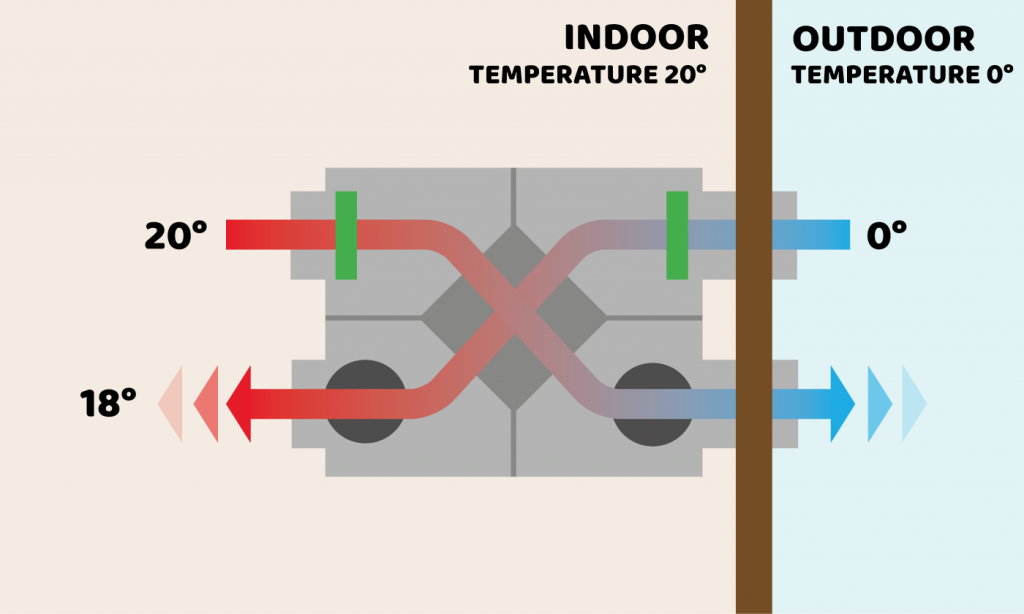Exactly How Heat Recovery Ventilation Boosts Indoor Air Top Quality and Reduces Power Expenses
Heat Recovery Ventilation (HRV) systems play a necessary role in boosting indoor air quality while all at once lowering energy expenditures. By successfully exchanging stale interior air with fresh outdoor air, HRVs aid preserve ideal moisture and minimize pollutants. In addition, their capability to recuperate warm from outward bound air minimizes the strain on home heating and cooling systems. As power costs proceed to increase, understanding the full possibility of HRV systems ends up being progressively important for home owners and organizations alike.
Understanding Heat Recovery Ventilation Solutions

Heat recovery ventilation (HRV) systems play a vital function in enhancing indoor air top quality, specifically in modern, energy-efficient structures. These systems are made to move heat from the outward bound stale air to the inbound fresh air, consequently lessening power loss while preserving suitable temperature levels inside your home. HRVs include a heat exchanger, fans, and ductwork, helping with the continual blood circulation of air. By getting rid of interior contaminants and introducing fresh air, HRVs aid to balance humidity levels, avoid mold and mildew growth, and reduce allergens. The efficiency of HRV systems hinges on their capability to recuperate up to 80% of the heat from the tired air, advertising energy preservation while ensuring a healthy and balanced interior environment. Their integration is important in attaining lasting living methods.
The Importance of Indoor Air Top Quality
Indoor air quality (IAQ) is an important factor affecting the health and wellness of residents in any type of setting. Poor IAQ can lead to different health issues, consisting of respiratory issues, allergic reactions, and exhaustion. Additionally, it can exacerbate status quo such as bronchial asthma. Elements contributing to low IAQ consist of pollutants from indoor resources like cleaning up agents, mold and mildew, and poor air flow. Preserving great IAQ is crucial for promoting a risk-free and comfortable living or functioning room. Effective methods to improve IAQ include routine surveillance of air top quality, appropriate air flow systems, and reducing making use of damaging substances inside your home. By focusing on IAQ, people can ensure a healthier setting that cultivates efficiency and general high quality of life.
Power Efficiency Perks of HRV Equipments
Several property owners and building managers are significantly recognizing the power effectiveness benefits of warmth recuperation air flow (HRV) systems. By transferring warm from tired indoor air to incoming fresh air, HRV systems considerably reduce the power required for heating & cooling. This process minimizes dependence on typical cooling and heating systems, resulting in his response lower energy bills. Additionally, HRVs aid maintain a balanced interior climate, stopping extreme heating or cooling down demands. The capacity to recover as much as 90% of the heat from outbound air likewise supports sustainability efforts by minimizing general power consumption. Consequently, HRV systems add not just to set you back savings yet also to a decreased carbon impact, lining up with the growing focus on energy-efficient building practices.
Installment and Maintenance Considerations
The reliable execution of warm healing ventilation (HRV) systems needs careful factor to consider of setup and upkeep aspects to ensure peak efficiency. Correct positioning of the HRV device is essential, as it ought to be mounted in an area that makes best use of air flow while decreasing sound disturbance. Furthermore, ductwork needs to be appropriately sized and protected to stop power loss. Routine upkeep, including filter replacement and system cleaning, is vital to secure ideal performance and indoor air top quality. Proprietors must develop a routine upkeep routine to recognize and address potential issues before they rise. Collaboration with click here for more knowledgeable professionals throughout both setup and maintenance stages can improve the longevity and performance of HRV systems, inevitably bring about much better indoor atmospheres and decreased energy costs.
Real-World Applications and Success Stories
Checking out real-world applications of warm recovery ventilation (HRV) systems discloses their significant influence on interior air high quality and energy efficiency throughout various settings. In property buildings, home owners have actually reported enhanced air quality, resulting in fewer allergic reactions and breathing problems. Schools executing HRV systems have actually noted enhanced pupil focus and decreased absence as a result of much better air flow. Business structures, such as offices and retail areas, have experienced lower power prices and raised worker performance. A business workplace in a pleasant environment achieved a 30% decrease in energy bills after installing an HRV system. These success stories demonstrate that HRV innovation not only contributes to healthier environments yet also supplies substantial monetary advantages, making it an important investment for different fields.
Often Asked Questions
Can HRV Systems Reduce Allergens in Indoor Air?
The performance of HRV systems in minimizing interior irritants primarily a knockout post depends upon their capacity to filter and exchange air. HRV Heat Recovery Ventilation. By continuously changing stagnant air, these systems can significantly reduce irritant levels throughout indoor atmospheres

Just How Does Humidity Affect HRV System Performance?
Humidity considerably influences HRV system efficiency; high levels can result in condensation, reducing effectiveness, while reduced humidity may enhance air exchange. Balancing humidity is necessary for ideal operation and preserving interior air high quality.
Are HRV Equipments Noisy During Procedure?
HRV systems can generate varying sound degrees throughout procedure, depending upon their style and setup. Some systems operate quietly, while others may create recognizable audio, particularly at higher air flow settings or when badly preserved.
What Is the Average Lifespan of an HRV System?

Can HRV Equipments Be Made Use Of in All Climates?
HRV systems can be utilized in different climates, but their efficiency may differ - HRV Heat Recovery Ventilation. In extreme temperatures, modifications or extra systems could be required to ensure ideal performance and convenience while maintaining indoor air top quality